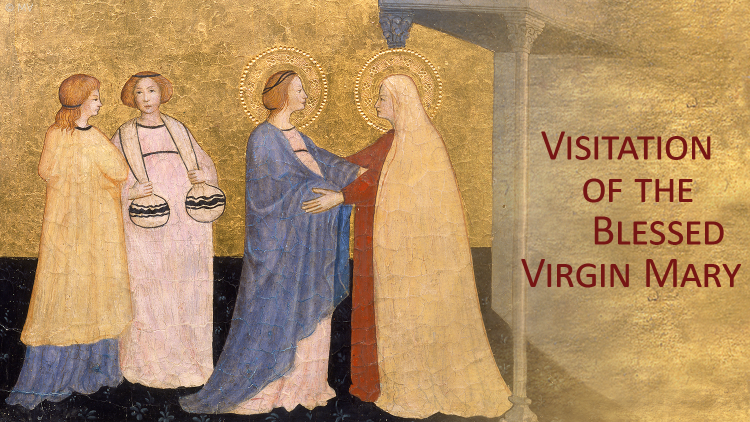
Feast of the Visitation of the Blessed Virgin Mary
This feast was established by Pope Urban VI in 1389 in order to bring the Great Schism to an end through the intercession of Mary. It originated in Byzantium when, on 2 July, the Gospel of Mary’s visit to Elizabeth was read on the Feast of the “Deposition in the Basilica of the Holy Garment of the Theotokos”. The Franciscans adopted this Marian feast day in 1263, calling it the Visitation of Mary. After the liturgical reform of the Second Vatican Council, the date for the feast was fixed on 31 May, at the end of the month dedicated to Mary.
Mary set out and traveled to the hill country in haste to a town of Judah, where she entered the house of Zechariah and greeted Elizabeth. When Elizabeth heard Mary’s greeting, the infant leaped in her womb, and Elizabeth, filled with the Holy Spirit, cried out in a loud voice and said, “Most blessed are you among women, and blessed is the fruit of your womb." (Lk. 1:39-42)
Traveling in haste
Because of a type of interior impulse, the Virgin Mary went hastily to her cousin Elizabeth. There are many possible reasons that drove the Virgin Mary to undertake that journey. It could have been the desire to be of service to her cousin, Elizabeth, knowing that she was expecting a baby at an advanced age. She may have wanted to communicate what had happened to herself, knowing that she would be more easily understood by another woman who had been “visited” by an angel. In her haste, Mary reveals herself to be a woman missionary (by bearing and sharing the joy of the annunciation) and a woman of charity (by being of service to her elder cousin).
But there is no reason why we can’t think that there was also a “holy desire” to go and see the “sign” that the Angel had given her: “And behold, Elizabeth, your relative, has also conceived a son in her old age, and this is the sixth month for her who was called barren; for nothing will be impossible for God” (Lk. 1:36-37). After all, even the shepherds went in haste to see “the sign” that the angels had announced to them on Christmas night: “And this will be a sign for you: you will find an infant wrapped in swaddling clothes and lying in a manger” (Lk. 2:12). This would confirm that Maria valued the “signs” that God offered her.
Two mothers meet
This Gospel scene connects the two “annunciations” of Elizabeth and Mary – two women and two promises. As soon as Elizabeth hears Mary’s greeting, the baby in Elizabeth’s womb begins to “dance”. Jesus, the Messiah, who is not yet born, but is present in his mother’s womb, meets his precursor, the prophet, who is also present in the womb of his mother, Elizabeth. He recognizes the cause of joy, of exultation, of dancing, as did David before the ark of the Lord’s presence (see 2 Sam. 6:12-15).
From praise to service
The Magnificat is a song of praise that recounts the overturning of human logic, where the last become first, not remaining a dead letter, and where life is made through service.
Prayer of Blessed Charles de Foucauld
Mary, solicitous Mother in the Visitation,
teach us how to listen to the Word,
a listening that makes us jump up quickly
and leads us toward the situations of poverty
where the presence of your Son is needed.
Teach is to bear Jesus,
silently and humbly as you did!
May our fraternity (families) be in the midst
of those who do not know him
to spread His Gospel
testifying to it not in words but with our lives;
not proclaiming it but living it!
Teach us to travel simply
as you did,
with our eyes always fixed on Jesus
present in your womb –
contemplating him, adoring him, and imitating him.
Mary, Woman of the Magnificat,
teach us to be faithful to our mission:
to bring Jesus to people!
Oh, beloved Mother, this is your own mission,
that Jesus first entrusted to you
and which you have willed to share with us.
Help us and intercede for us so that we might do
what you did in the house of Zechariah:
to glorify God and sanctify people in Jesus,
thanks to Him and for Him! Amen!








